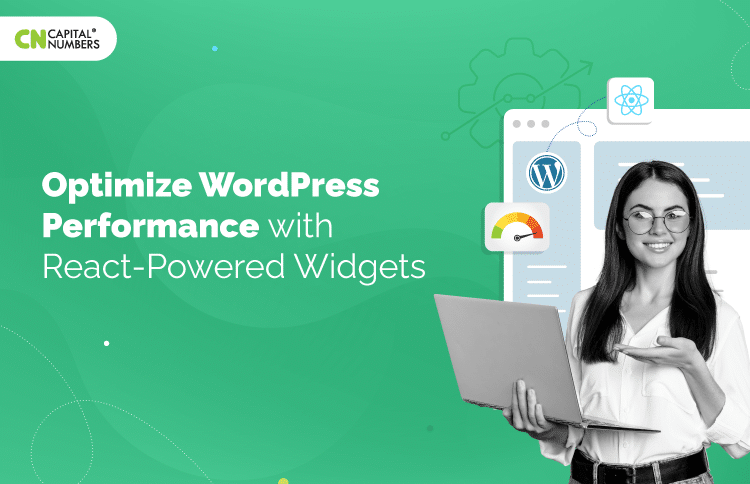The Next-Level of WordPress Performance Optimization with React-Powered Widgets
Table of Contents
In today’s digital world, the speed and responsiveness of your website are crucial for keeping your users happy and engaged. Making your site faster and more responsive isn’t just a nice-to-have; it’s absolutely necessary. Thanks to ReactJS, a state-of-the-art JavaScript library, how we develop websites has been revolutionized. Its efficient, reusable components and dynamic interfaces can dramatically improve your site.
Combining ReactJS with WordPress will unlock incredible possibilities, especially for expert WordPress developers with ReactJS expertise, for creating websites that perform exceptionally well. ReactJS shines because it allows you to reuse code and build websites that refresh seamlessly without needing a page to reload. This works hand-in-hand with WordPress, your trusted platform for content management. When you integrate ReactJS into your WordPress plugins, you’re stepping into a space filled with opportunities to incorporate engaging interactive elements, streamline information management, and access a vast array of tools that enhance the user experience on your site. This powerful mix is your ticket to creating standout websites that draw in visitors and keep them coming back for more.
Benefits of Using WordPress with React.js:
Integrating ReactJS with WordPress offers many benefits that can change the game for you when building websites. ReactJS, a powerful JavaScript library for building interactive user interfaces, and when you pair it with WordPress, you get the best of both worlds. This combo lets you use the latest tech in a way that’s easy to manage, helping you create websites that are not only dynamic but also super engaging for users.
- Responsive and Highly Optimized Websites: ReactJS enables efficient rendering of components, leading to faster page load times and enhanced user experience.
- Virtual DOM Technology: Integration of ReactJS with WordPress allows for dynamic content updates without full-page refreshes, thanks to its virtual DOM technology.
- Code Reusability: ReactJS promotes code reusability, allowing developers to reuse components across platforms and functions and streamlining development efforts.
- Faster Speed: The streamlined website structure and efficient ReactJS render process contribute to faster overall website performance, improving user satisfaction.
- Data Separation and Presentation: ReactJS facilitates the separation of data and presentation, ensuring data integrity and enhancing website manageability.
In essence, merging ReactJS with WordPress empowers developers to craft sophisticated, high-performance websites effortlessly and efficiently.
Sample Code: Front-End Post Listing Widget with React Components
1Create a New WordPress Plugin:
- Inside the WordPress plugins directory (wp-content/plugins), create a new folder for your plugin, let’s name it “react-post-listing-widget”.
- Create a main PHP file (e.g., react-post-listing-widget.php) and add the necessary plugin header information:
<?php /* Plugin Name: React Post Listing Widget Description: A custom WordPress widget for listing recent posts using React. Version: 1.0 Author: Your Name */ // Plugin code will go here
2Set Up Your Plugin Structure:
- Inside the “react-post-listing-widget” folder, create a subdirectory named “src” for your JavaScript files.
- Install necessary dependencies and set up your build tools (e.g., Webpack, Babel) for compiling React components.
3Develop Your React Components:
- Create a React component named “PostListing” in a file named “PostListing.js” within the “src” directory.
- Here’s a sample code for the “PostListing” component:
Jsx import React, { useState, useEffect } from 'react'; const PostListing = () => { const [posts, setPosts] = useState([]); useEffect(() => { // Fetch recent posts from WordPress REST API fetch('/wp-json/wp/v2/posts') .then(response => response.json()) .then(data => setPosts(data)) .catch(error => console.error('Error fetching posts:', error)); }, []); return ( <div> <h2>Recent Posts</h2> <ul> {posts.map(post => ( <li key={post.id}> <a href={post.link}>{post.title.rendered}</a> </li> ))} </ul> </div> ); }; export default PostListing;
4Integrate React with WordPress:
- Enqueue React and ReactDOM scripts in your plugin PHP file:
<?php function enqueue_react_scripts() { wp_enqueue_script('react', 'https://unpkg.com/react@17/umd/react.development.js'); wp_enqueue_script('react-dom', 'https://unpkg.com/react-dom@17/umd/react-dom.development.js'); } add_action('wp_enqueue_scripts', 'enqueue_react_scripts');
5Build Your WordPress Widget:
- Register a new widget area in your plugin PHP file:
'Post Listing Widget', 'id' => 'post-listing-widget', 'before_widget' => '<div id="%1$s" class="widget %2$s">', 'after_widget' => '</div>', 'before_title' => '<h2 class="widget-title">', 'after_title' => '</h2>', )); } add_action('widgets_init', 'register_post_listing_widget');
6Render React Components in Your Widget:
- Use JavaScript to render your React components within the widget area:
</div>'; echo '<script src="' . plugins_url('/build/main.js', __FILE__) . '"></script>'; }
7Test Your Plugin:
- Activate your plugin in the WordPress admin dashboard.
- Add the “Post Listing Widget” to a widget area in a WordPress theme.
Exploring the Future of WordPress Plugin Development with ReactJS:
In the fast-moving world of web development, ReactJS and WordPress team up to transform the way plugins are made, opening up endless opportunities for digital innovation.
- Seamless Integration: ReactJS facilitates effortless integration of WordPress plugins with diverse systems and platforms, enabling seamless connectivity with APIs and external databases.
- Enhanced User Experience: With ReactJS, developers craft immersive WordPress plugins, offering real-time updates, intuitive navigation, and interactive elements for a captivating user journey.
- Mobile-Friendly Solutions: Addressing the surge in mobile device usage, ReactJS empowers developers to design responsive plugins, ensuring optimal performance across various screen sizes and devices.
- Performance Optimization: Leveraging ReactJS’s lightweight architecture, WordPress plugins load swiftly, delivering enhanced speed and efficiency for a seamless browsing experience.
- Customization and Modularity: WordPress’s renowned customization options are amplified with ReactJS, allowing developers to create modular and customizable plugins tailored to specific design preferences and user requirements.
You may also read: A Step-by-Step Guide to Build a Headless WordPress Website with React.
The Bottom Line:
The powerful combination of ReactJS and WordPress unlocks a new era of plugin development. This exciting convergence empowers developers with cutting-edge tools to create innovative and engaging user experiences. Gone are the limits – creativity flourishes, and user engagement reaches new heights!

















